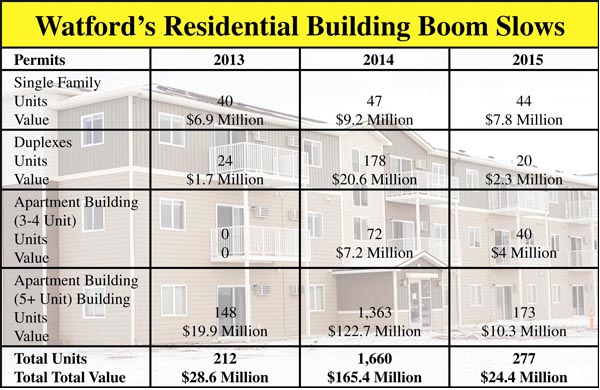Watford’s building boom slows

By Amy Robinson
Farmer Staff Writer
After a record year of building in Watford City in 2014, 2015 was a year that offered the community a chance to slow down and really catch up to the whirlwind of everything that materialized the previous year.
Looking back over the last three years, 2014 was a revolutionary year in Watford City, making its stamp in western North Dakota history forever. In one year, from 2013 to 2014, the number of building permits issued increased by almost 100 percent! In 2013, the City of Watford City issued 263 building permits. And in 2014, the city issued 513 permits.
Not only did the percentage of building permits increase, so did the valuation of those buildings. In 2013, the total was $85.2 million in new construction, and in 2014, new construction increased 275 percent to a record $234.2 million.
According to Watford City permit record reports, 212 residential permits were issued by the city in 2013. That number substantially increased in 2014 by approximately 780 percent, to a whopping 1,660 total residential permits. In 2013, developers invested $28.6 million in new residential projects, while $159.8 million was spent for new apartments and housing units in Watford City in 2014, a 550 percent increase.
“2014 was a historic year of construction,” stated Watford City Mayor Brent Sanford. “The previous three or four years of city and investor groundwork came to fruition. More units were built in 2014 than were in existence prior to 2014. And oil prices were still heading upward. Demand for housing was still far ahead of supply in housing units, with no end in sight.”
As oil prices started declining toward the end of 2014 and into the beginning of 2015, Sanford says developers started scaling back on the multi-family projects for 2015.
According to the city’s permit record reports, 148 (5-plus apartment units) permits were issued in 2013. In 2014, the number of 5-plus apartment unit permits increased to 1,363. But in 2015, that number decreased more than 750 percent to a total of 173 permits issued for multi-family units.
Although the numbers across the board dropped in 2015, they were still higher than what they were in 2013.
“You notice a drop in building permits for residential units from 2014 to 2015,” stated Sanford. “But it was still more than in 2013, as developers and the City of Watford City were still trying to figure out how to install the infrastructure at that point. A major reason that building activity was still at a higher lever for 2015 was due to the beginning of the larger community construction projects - the new high school, the Events Center, and the Law Enforcement Center.”
According to Sanford, these projects will continue into 2016, at which time construction of the new healthcare facility will also begin.
Various commercial construction projects are still coming online in 2016 as well. However, says Sanford, 2016 looks to be a slower year for residential construction at this point.
“Things can change if oil prices spike before late spring or early summer,” states Sanford. “Otherwise, the construction season would be missed. However, the single family home construction has been steady in 2013, 2014, and 2015, at the 40 to 50 units per year level.”
Sanford also says that the single family construction market is complicated. Basically it is the riskiest venture for developers and banks, as well as the home-buyer. Especially when the oil prices are creating so much employment concern.
“Outside observers feel we need a lot more single family homes,” Sanford said. “Single family home developers want to have some assurance that our market indeed has the single family home-buyers.”
According to Sanford, the long-term outlook still calls for the need for over 10,000 permanent housing units in the area based on the total number of wells planned for the area
“The county planning department has determined that we have approximately 9,000 total housing units in the county currently,” says Sanford, “only 4,000 of which are permanent construction, so the rest are mobile homes, RVs, and cabins.”
Sanford says that means the city is still 6,000 permanent housing units short from the eventual goal of 10,000. But until oil prices at least show signs of recovery, real estate investors might be more cautious when investing their own funds toward the community’s future projected needs.
The bottom line, according to Sanford, is although the building boom of 2014 slowed down in 2015, the need for residential housing units is still there and the community has a lot to be proud of, especially when it comes to the multiple community infrastructure projects. 2016 will be a year highlighting the completion of several multi-million dollar projects that will only enhance this Boomtown.
